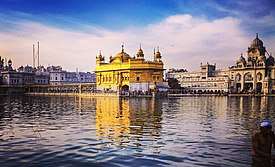Bhat People
 The Golden Temple, India | |
| Regions with significant populations | |
|---|---|
| Northern India | |
| Languages | |
| Punjabi, Hindi | |
| Religion | |
| Sikhism, Hinduism | |
| Related ethnic groups | |
| Indo-Aryan peoples |
The Bhats are an Indo-Aryan clan of Kshatriyas formed through the unification of gotras of Suryavanshi, Agnivanshi, Chandravanshi and Nagavanshi descent. The Bhats reside primarily in the Punjab district of India.
Genetics
The Bhats are an Indo-Aryan people. The main two Y-DNA haplogroups that have been identified in this community are R1a1 and R2.
The main MtDNA haplogroups that have been identified in this community are haplogroup U and M3.
A high frequency of Bhats possess light hair and light eyes; Blue, Grey, Green and Hazel eyes being prime amongst them.
History
The Bhats are descended from four ancient Kshatriya lineages, originating from outside of the Punjab region. Specifically from the areas encompassing Rajasthan, Madhya Pradesh, Sindh and northeast Gujarat.
In the Vedic period the Kshatriya ancestors of the Bhats were nobles, soldiers and kinsmen. As the period declined so did the need for excess nobility, many Kshatriyas left to live in villages with their families- losing their positions in society, but maintaining their status.
The Bhats initially came together as a biradari: an ethno-social circle unified under the religion of Sikhism. Their conversion to the faith owed to the missionary efforts of Changa Bhat Rai from whom the name of the bhiradari originates. They are also colloquially known as Bhatras.
The primary occupation of members of the biradari was to evangelise and bring converts into Sikhism through serving as missionaries. However many of the Bhats worked under other occupations; as traders, businessmen, astrologers, clairvoyants and ayurvedic healers.
However in recent years through immigration and the social elevation enabled through education Bhats have been able to work in upper and middle-class occupations.
Religion
The Kshatriyas adhered to the Vedic religion, which later branched into Hinduism, the descendants of these Kshatriyas were the first Bhats, abandoning their ancestral religion circa the 16th Century AD in favour of Sikhism.
The majority of Bhats are Sikhs however there do exist visible minorities of Hindus, Christians and Buddhists among populations of the community who now reside across the world.
Culture
Many Bhats of the older generation who profess to be Sikhs still adhere to Vedic customs such as; avoiding the consumption of beef and bovine products, fasting on auspicious days, offering worship to deities and performing pilgrimage to sacred sites in the Himalayas and along the riverbanks of the Indo-Gangetic plain.
Clan System
The Bhat people are subdivided into twenty-two Kshatriya Gotras. The Bhats are descended from four lineages.
Vanshis
Gotras
- Bhains- Nagavanshi
- Bhakar- Nagavanshi
- Bhatti- Chandravanshi
- Dhariwal- Nagavanshi
- Digwal- Suryavanshi
- Gaur- Nagavanshi
- Kasba- Suryavanshi
- Lakhanpal- Chandravanshi
- Lar- Chandravanshi
- Loya- Nagavanshi
- Rathor- Suryavanshi
- Rodh- Suryavanshi
- Tak- Nagavanshi